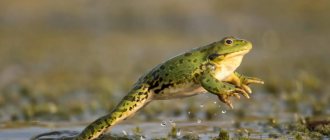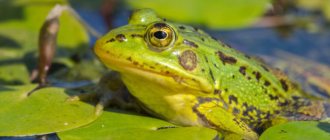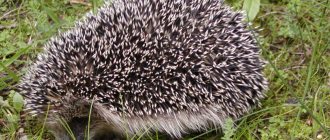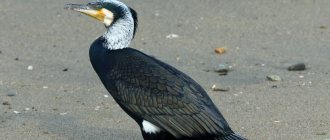aquatic mammals of the suborder odontocetes, closely related to porpoises.
Also on topic:
MARINE BIOLOGY
Dolphins, like all cetaceans, breathe air, periodically rising to the surface to inhale through a single modified nostril - a blowhole located on the crown of the head. They feed primarily on fish and squid, although some species prefer shrimp and other crustaceans, and killer whales also eat sea turtles, aquatic mammals and birds. In most dolphins, males are larger than females and in some species they have a higher dorsal fin. After a gestation period of 12 to 16 months, depending on the species, a single calf is born. The mother feeds it underwater with milk for at least six months, and sometimes up to two years, beginning to wean it from the nipple after 6–18 months. Individuals up to 50 years old are known, although most species have a maximum lifespan of 20–25 years.
Species of the dolphin family (Delphinidae) live in all open seas and sometimes enter the mouths of large rivers. Representatives of the family of freshwater, or river, dolphins (Platanistidae) have a much more limited distribution. For the most part they inhabit inland fresh water bodies, although some of them can penetrate brackish-water estuaries and even coastal zones of the seas. The family Stenidae includes species that live in seas, fresh waters, or both.
Externally, dolphins are distinguished primarily by their protruding beak, which is clearly demarcated from the forehead. The exception is a few species with a convex, spherical forehead. Depending on the species, dolphins have from 2 to 250 conical teeth. The dorsal fin, if present, is usually crescent-shaped rather than triangular; if it is not curved, then it is very high, like that of a male killer whale. Freshwater dolphins are distinguished by the fact that their neck vertebrae are divided, like those of land mammals, rather than fused into a single bone. Some species of this family, in addition to conical teeth, have molar-shaped teeth, i.e. close in structure to the indigenous ones. The dorsal fin is usually very low, in the form of a ridge; only in the Laplatan dolphin it is the same as in the delphinids.
Most dolphins live in schools and can, like the common dolphin, form huge aggregations. However, their groups are usually small: from 2–3 to approximately 100 individuals. At least some species appear to have a distinct social organization.
Dolphins are generally very active and often swim extremely fast, occasionally jumping out of the water. Some species, such as the long-snouted dolphin, even perform intricate figures in the air, while others like to swing on the waves diverging from the bow of a moving vessel.
Most dolphins have a wide repertoire of sounds produced. Firstly, these are impulse signals of two main types: echolocation and expressing an emotional state. Secondly, dolphins make monotonous sounds that resemble a whistle. In individuals of some species, its frequency is individual and is used to recognize each other by members of the pack. In addition, the volume and frequency of the whistle reflect the emotional state of the dolphin. Some individuals have auxiliary monotonous signals, which are also stereotypical and characteristic of each of them.
Non-local pulses, called chirps, come in many types that are typically species-specific rather than individual-specific. Attempts are being made to find a connection between various chirps and the behavior of dolphins, but all chirps are for the most part similar to each other and smoothly transition into each other. Although such signals reflect a particular emotional state, it is clearer to other dolphins than to human observers, and there is no evidence that these sounds actually constitute language in the human sense. The same can be said for monotonous whistles.
bottlenose dolphins
(Tursiops
).
Of the species of this genus, the most famous is the Atlantic, or simply bottlenose dolphin ( T. truncatus
), widely distributed in warm waters around the world. Sometimes several of its subspecies are distinguished, which some scientists consider to be independent species. Bottlenose dolphins are widely used for research and training. Their body is grayish, up to 3.6 m long (in captivity it is rarely more than 2.4 m). All bottlenose dolphins eat fish; on each side of the upper and lower jaws they have approx. 20–25 teeth. Although sexual maturity occurs at 7–8 years, at least the males reproduce most actively, becoming approximately twice their age. Pregnancy lasts about a year, and the cubs are fed milk until 18 months, although they begin to consume solid food a year earlier. Immediately after birth, the baby floats to the surface on its own to breathe in air. For the first few months he stays close to his mother. Her fast swimming does not violate this close physical connection, since the female, by slightly increasing her energy expenditure, generates hydrodynamic forces, with the help of which she ensures the movement of both herself and the calf.
Bottlenose dolphins usually migrate in small schools of fewer than a dozen individuals, but sometimes several hundred animals can be seen at once. It is these dolphins that most often flash along beaches, in shallow bays and estuaries, although in cold waters you can often see common porpoises there. Wild bottlenose dolphins have been observed in New Zealand, Florida and Scotland regularly playing with people swimming. Such individuals were always found in the same areas and, it seems, were not at all afraid of humans, even allowing themselves to be touched. But such cases are rare. Bottlenose dolphins often bob on the waves in front of the bows of sailing ships - usually this is the closest contact with humans that they allow in nature.
Sound signals and echolocation abilities have also been studied, mainly in bottlenose dolphins. They most often tried to attribute the existence of language, but this hypothesis has not yet been confirmed.
Reproduction and lifespan
Before impregnating a female, a male dolphin undergoes a mandatory courtship ritual. Moreover, during this period he can “look” at other representatives of the fair half of the dolphins. In this way, dolphins are also very similar to people.
Having chosen one female that is suitable in all respects, the male begins to communicate with her. If the female does not mind communication, courtship moves into the next phase - pursuit. Then, through cross-swimming, the male dolphin, as if by chance, touches his chosen one with light, unobtrusive touches of his fin.
Also, during courtship, the male constantly advertises himself, placing himself in all favorable angles, in addition, he tries to lure the “lady of his heart” with the help of the famous dolphin song . Not a single female can remain indifferent to such attention, and as a result, the process of copulation occurs directly.
Dolphins carry their young for 12 months. “Babies” are usually born tail first and immediately begin to swim. The female’s task is only to show them the way to the surface of the water, where they can breathe air.
The bond between mother and child in dolphins is very strong. Their relationship can last up to eight years. The average lifespan of dolphins is about 50 years (maximum 75 years). Which also gives them a resemblance to humans.
common dolphin
(Delphinus delphis
) from the genus of common dolphins - one of the most common representatives of the family in the Mediterranean Sea. This is a very beautiful dolphin, with black circles around the eyes and yellow and gray markings on the sides, the pattern of which resembles the letter "X". Sometimes in the open sea you can see a huge number of these slender, bright animals at once. Squirrels inhabit warm and temperate seas around the world. They are usually divided into three subspecies: one in the Atlantic and, possibly, the Indian Oceans, another in the Pacific and a third in the Black Sea. Independent, although closely related, forms are sometimes isolated for South Africa, Japan and the Red Sea. Female white-sided moths give birth to a calf approximately 3 times every 4 years and feed it for 4–5 months. It is believed that the maximum lifespan of this species is more than 20 years.
Security
Some species and subspecies of dolphins are on the verge of extinction and are protected by local and international legislation. One example is the New Zealand subspecies of Hector's dolphin known as the Maui dolphin ( Cephalorhynchus hectori maui
). In total, fewer than 150 of these dolphins live in the waters of New Zealand's North Island.
Since 1966, after the adoption of the CITES Convention (Appendix 2), dolphin fishing was prohibited in the USSR. Türkiye has not yet ratified this treaty.
2007 was declared by the UN as the “Year of the Dolphin” and, due to its success, was extended to 2008.
Short-headed dolphins
(Lagenorhynchus
) are represented by several types: depending on the classification used, their number can reach up to six.
Representatives of this genus usually inhabit colder waters than other dolphins, and some species even reach pack ice. One of them, the Pacific striped dolphin ( L. obliquidens
), is regularly exhibited in several aquariums and is remarkable for its ability to leap over a high-hanging bar. When short-headed dolphins live with other species of the family, they are very friendly and caring towards other people's offspring. Their flocks are not as large as those of white sideds, but sometimes number up to 1,500 individuals.
A distinctive feature of the genus is a distinct groove on the beak, but the beak itself is not as long as many other dolphins and is not as noticeable to the casual observer. As a result, from a distance they can be confused with porpoises.
Price
These cute, smiling creatures cannot leave anyone indifferent. That is why in almost every corner of the globe there are many dolphinariums, which organize various shows with dolphins .
They also offer to swim with dolphins , feed them, and also take a photo with a dolphin . For children, such a pastime will be an unforgettable event.
In addition, swimming with dolphins has a beneficial effect on the treatment of diseases of the musculoskeletal system in children. And it wouldn’t hurt for adults to take their minds off their problems by spending time with these good-natured creatures.
Some fairly wealthy people prefer to have their own dolphinariums. But of course, no one will give a dolphin for free The official price of a dolphin is about 100 thousand US dollars.
On the black market they can be purchased for 25 thousand dollars, but in this case there is no guarantee that the dolphin will live long, since the conditions of their detention leave much to be desired. After all, a dead dolphin cannot bring joy to anyone.
Of course, watching dolphins play is a great pleasure. But before you decide to take such a responsible step as purchasing a dolphin as a pet, you need to be prepared for the fact that it needs appropriate conditions, special food and daily care. After all, a dolphin is not just a pet, but a creature very similar to us, only much kinder and more defenseless.
Prodolphins
(Stenella
) are very diverse in color, number of teeth and other structural features. This is the largest genus of the family in terms of the number of species, and many of them are quite common. Experts believe that the taxonomy for this group is poorly designed. The number of teeth, depending on the species, ranges from 37 to 50 on each side of each jaw. The coloration varies from light spots on a dark background to similar to the pattern of the common dolphin, having a dark back and stripes around the head and on the sides on a light background. Some dolphins are long and slender, with a very elongated snout, while others have a more massive body and a much shorter snout. Most species live offshore in tropical and temperate waters around the world. They are good swimmers and often bob on the waves in front of ships.
Atlantic spotted dolphin ( S. plagiodon
) and its close eastern Pacific relative
S. graffimani
are sometimes shown in aquariums.
The first species is a spectacular jumper, often jumping over the head of the person feeding it. In captivity, dolphins feed on fish, but in nature their favorite food is squid. The striped dolphin ( S. caeruleoalba
) is a commercial species in Japan; sometimes it is shown to the public.
Speech
These mammals can communicate with each other using signals and sounds. Moreover, each of them has their own voice! With such signals, animals report the presence of food, impending danger and the desire to play. Their language is very diverse.
Scientists have found that dolphins can combine ordinary sounds into words and even entire sentences to convey information. And this is a real speech!
Their vocal spectrum is unusually wide and ranges from low frequencies to ultrasound.
Pilot whales or ball-headed dolphins
(Globicephala
), a very large species: animals reach a length of 6.5 m and a weight of approx. 2 tons. They are characterized by a huge pillow on the forehead containing viscous fat. The body is black with a white mark on the chest and the same line below the middle of the belly. This pattern, as well as the light "saddle" on the back behind the dorsal fin, typical of some forms, are not always clearly defined. There are three types.
Pilot whales typically live in warm to temperate waters, but may migrate into relatively cold areas during the summer. It has been proven that they have seasonal migrations, carried out in flocks of up to several hundred individuals. They all often move forward, simultaneously emerging and submerging, as if at the command of the leader. Apparently, the flocks sometimes stop to rest, but even then their formation usually remains military-correct, and the animals surface to take a breath as synchronously as during movement. Sometimes entire flocks of pilot whales are thrown onto land and die. The reasons for this behavior are unknown.
Pilot whales feed almost exclusively on squid, but in captivity their diet may include fish. Females usually reach sexual maturity at 6–7 years, and males sometimes only reach 12 years. Pregnancy lasts approx. 16 months Although the cub can eat solid food from 6 months of age, milk feeding continues until 2 years of age.
Paradoxical speed
It is no secret that dolphins can reach speeds of 40-50 km/h in the water. But these numbers frankly surprised zoologists. Back in 1936, calculations were carried out that showed the maximum speed for animals with such physical indicators was 20 km/h. The English zoologist James Gray undertook to study the paradox. According to his calculations, it turned out that either dolphins’ muscles should be 8-10 times more powerful than those of a similar mammal, or dolphins, when moving in water, experience significantly less resistance relative to the physical model. But how can this be? This phenomenon came to be called Gray's paradox. Over time, scientists have figured out how the dolphin controls its environment - its soft skin dampens the vibrations of the water and it flows smoothly, without turbulence, around the body. This is facilitated by both lubricant and special longitudinal ridges.
But at a speed of 10-15 meters per second, the effect of cavitation appears - air bubbles form near the actively working tail. It turns out that the dolphin senses them through the nerve endings in the form of pain. So nature simply does not allow these animals to swim even faster, stopping the acceleration with unpleasant sensations. Not all aspects of dolphin speed swimming are yet completely clear, but this is a very interesting mystery.
♥ ON TOPIC: The deepest holes in the world.
killer whale
(Orcinus orca
) - the largest and most beautiful species of dolphins, distinguished by a bright black and white pattern; their weight is up to 8 tons. This species inhabits all seas, from the coldest to the warmest, staying mostly close to the shore. This is the only cetacean that, in addition to fish, feeds on aquatic mammals, sea turtles and birds.
Killer whales are characterized by pronounced sexual dimorphism. Males reach a length of 9 m - a meter and a half more than females. In addition, their dorsal fin is high and almost straight, while in adult females it is approximately half as low and curved. Unlike most dolphins, the killer whale's pectoral flippers are not pointed and sickle-shaped, but wide and paddle-shaped.
These animals are very voracious and hunt in packs, attacking not only small animals, but also huge baleen whales, from whose bodies they tear pieces of meat. In addition to warm-blooded animals, killer whales eat a large amount of fish, which actually forms the basis of their diet. Despite the bad reputation of these animals, called "killer whales", there is no conclusive evidence of their attacks on humans. In contrast, in captivity, orcas are very docile and allow people to ride on their backs, and the trainer can put his head into their open mouth without fear. They are highly trainable, able to jump almost completely out of the water and perform complex sets of exercises.
Manifestations of intelligence
Just watch dolphins for a short time and you will understand how smart they are. It is no coincidence that there is so much research being done on these creatures. Most often, scientists came to the attention of representatives of the most famous and widespread species - the bottlenose dolphin. The study of dolphin intelligence was frankly surprising.
Even dolphins living in captivity can remember whistles of different tones for years. Moreover, animals can imitate the sounds produced by computers. Biologists have tried to associate sounds with objects, like a ball or a hoop. Dolphins quickly understand this connection and name the necessary objects with vocalizations. In fact, this can be considered learning a new vocabulary. And wild dolphins show similar capabilities, identifying each other with a signature sound and remembering it for many years.
Proof of high intelligence was the passing of two bottlenose dolphins in 2001 in a mirror test at a New York aquarium. Scientists applied marks in the form of geometric shapes to dolphin bodies. The animals studied their new appearance in the mirror for a long time, which suggests that they recognized their identity. But very few animals are capable of this.
Lesser or black killer whale
(Pseudorca crassidens
), with large sharp teeth it is very similar to an ordinary killer whale, and in size and color it resembles a pilot whale, differing in a much more streamlined body shape. There are no records of this species attacking warm-blooded marine animals, but its feeding method is unusual: the killer whale often grabs very large fish and tears them apart in much the same way as the common killer whale tears seals, small dolphins or porpoises. Like pilot whales, these animals sometimes wash ashore.
Gray dolphin
(Grampus griseus
) is very similar in appearance to the pilot whale, but differs in the presence of teeth, usually only on the lower jaw, a deep groove on the forehead and a large number of scars scattered throughout the body. Males have especially many of them: it is believed that in most cases these are traces of battles with relatives. The markings are so distinctive that they were previously mistaken for being part of the gray dolphin's natural pigmentation. This species feeds mainly on squid and lives in all seas except the polar ones.
Absolute pitch
It is believed that dolphins have a poor sense of smell, but excellent vision and hearing. Echolocation is an important tool for dolphins, helping them navigate through the water and find each other and their prey. Moreover, it is the echolocator that makes it possible to recognize people due to the characteristic “response” of our skeleton. But these same waves help to see other human insides. A pregnancy that has recently begun will be easily detected by dolphins. That is why they react so joyfully and violently to pregnant women.
♥ ON TOPIC: 30 of the most famous fake photos that you could believe.
Other dolphins.
The dolphin family includes many rare or little-known species. The pygmy killer whale ( Feresa
attenuata
) is very similar in appearance to the pygmy killer whale, but much smaller. It is found only in the South Pacific, off the coasts of Japan and Senegal, and is rarely kept in captivity.
Irrawaddy dolphin ( Orcaella brevirostris
) has two subspecies.
One lives in the Irrawaddy River in Burma, and the other in the seas from the Bay of Bengal to Borneo and Java. The beakless or broad-snouted dolphin ( Peponocephala electra
) is found in the tropical waters of the Atlantic, Pacific and Indian oceans.
There are two species of dorsal-finless whale dolphins ( Lissodelphis
): northern (
L. borealis
) is noted in the northern part of the Pacific Ocean, and southern (
L. peroni
) - in the temperate zone of the Southern Hemisphere.
Genus of beaked or spotted dolphins ( Cephalorhynchus
) includes several southern, mainly cold-water species.
They are small in size and characterized by a bright black and white color. The Sarawak dolphin ( Lagenodelphis hosei
) is known from only one skeleton found on the island of Borneo.
Large-toothed dolphins
(Steno
) is a monotypic genus.
Its only species, the common dolphin ( S. bredanensis
), is widespread in temperate and tropical seas, where it is found only offshore. Its snout is long, but not as sharply demarcated from the forehead as in most dolphins, but rather smoothly passing into the upper part of the head. The dark gray coloring of the back gradually becomes lighter on the sides and becomes very light on the belly. The species got its name because of its teeth with a ribbed, uneven surface. The biology of the animal has been little studied, but it is known that it feeds on fish, squid and octopuses. Although these dolphins are considered a rare species, significant numbers of them are sometimes captured around the Hawaiian Islands for studies of vocalizations and local migrations. Like representatives of the dolphin family, they emit both monotonous whistles and various pulsed signals.
Hunting
Dolphin hunting is now prohibited. Despite this, in many places these beautiful animals are being caught and their numbers are inevitably declining.
Hunting is an incredibly cruel and senseless endeavor that makes absolutely no economic sense.
People do not eat dolphin meat; it is used only for animal feed. In addition to fishing nets, many of these beautiful animals are killed due to extensive oil spills and under ship propellers.
These mammals are often illegally captured and sold to water parks and various shows, where they undergo a special training program.
Long-beaked dolphins
(Sotalia
) two kinds.
Both are found in South America, but in different ecological niches. The Guiana dolphin ( S. guianensis
) inhabits coastal marine waters and estuaries in northeastern South America from Rio de Janeiro to Venezuela.
The Amazon dolphin, or tukashi ( S. fluviatilis
), lives only in the fresh waters of the Amazon basin and often swims into flooded jungles during floods.
Long-beaked dolphins feed on fish, but the details of their biology are still little known.
Amazonian inia, or buto
(Inia geoffrensis
). Young animals are light gray, but with age they gradually acquire a pinkish tint. Their very long snout is covered with stiff hairs or bristles, which apparently serve a sensory function. Amazon hoarfish have an average of 25–27 teeth on each side of each jaw. The front teeth are pointed, conical, and the back teeth are somewhat similar to molars. Two types of teeth and unfused cervical vertebrae are primitive features for cetaceans. Inia feeds on fish, including those covered with bony plates, and its teeth are often heavily worn, apparently from chewing hard food.
According to some reports, inia may have several subspecies. These freshwater cetaceans are common in the Amazon and Orinoco river basins and during floods they even penetrate into flooded forests, where they swim between the trees. When searching for food on the bottom, inias often turn belly up, perhaps because their thick cheeks would otherwise obstruct their view. Studies of the sounds they make have shown the presence of a rich repertoire of pulse signals, including echolocation signals, used to search for food and explore the environment; however, no monotonal whistles were detected.
Gangetic dolphin, or susuk
(Platanista gangetica
), lives in the Indian rivers Indus, Ganges and Brahmaputra. He is apparently blind, as his eyes lack a lens. However, the animals compensate for this deficiency by developing an unusual cup-shaped depression on the skull, which resembles an enlarged reflector of a flashlight and undoubtedly directs and concentrates echolocation signals. Studies of several living specimens of this species have demonstrated their apparently exceptional echolocation abilities. The Gangetic dolphin is believed to feed on freshwater shrimp and burrowing fish, which it catches by probing the bottom with its very long jaws. Surprisingly, this animal usually swims on its side.
Chinese lake dolphin
(Lipotes vexillifer
) lives in the central-eastern part of China in the Yangtze (Changjiang) and Qiangtang rivers, as well as lakes Dongting and Poyang. For a long time this species was classified as a member of the family Platanistidae, but is now often classified as an independent family Lipotidae. The animal reaches a length of 2.5 m, and the mass of one of the studied specimens was 160 kg. In appearance it is closest to the Amazonian inia. Chinese lake dolphins feed on fish, in particular catfish, which they pull out of the bottom mud with their long beaks. They usually move in pairs, forming a larger group of about ten individuals.











